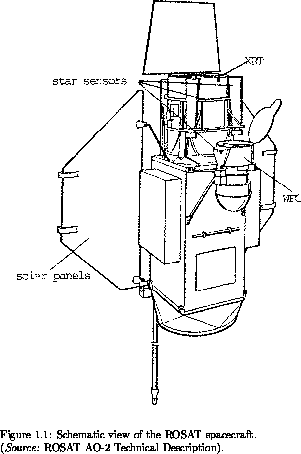The ROSAT Mission
Overview
ROSAT, the ROentgen SATellite, was an X-ray observatory developed through a cooperative program between the Germany, the United States, and the United Kingdom. The satellite was designed and operated by Germany, and was launched by the United States on June 1, 1990. It was turned off on February 12, 1999.
Power was supplied through 3 solar panels providing 1 kW of power
during Sun-lit parts of the orbit, and through a rechargeable battery
during the shadow phase (spacecraft night, up to 40 minutes per
orbit).

Instrumentation
The scientific payload consists two coaligned scientific experiments, the The X-Ray Telescope which is used in conjunection with one of the focal plane instruments: and the The Wide Field Camera which has its own mirror system and star sensor. ROSAT provides a ~ 2 degree diameter field of view with the PSPC in the focal plane, and ~ 40 arcmin diameter field of view with the HRI in the focal plane. The ROSAT mission began with a six-month, all-sky PSPC survey, after which the satellite began a series of pointed observations that will continue for the duration of the project.
On September 11, 1994, after four years of successful operation, the PSPC was shut down to conserve the remaining detector gas. This remaining gas was thought to have been used up during 1997 in a series of pointings to complete the all-sky survey coverage, but several other PSPC observations were carried out in 1998 and early 1999. For more detailed information on different aspects of the ROSAT project, select one of the following:
Last Update: Jan 11, 1995
Curator:
HEASARC Guest Observer Facility
Please use the Feedback link if you have questions on ROSAT.

